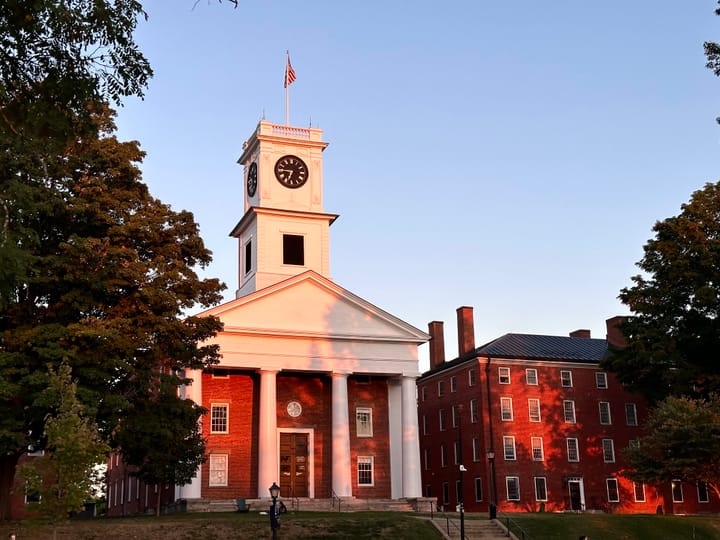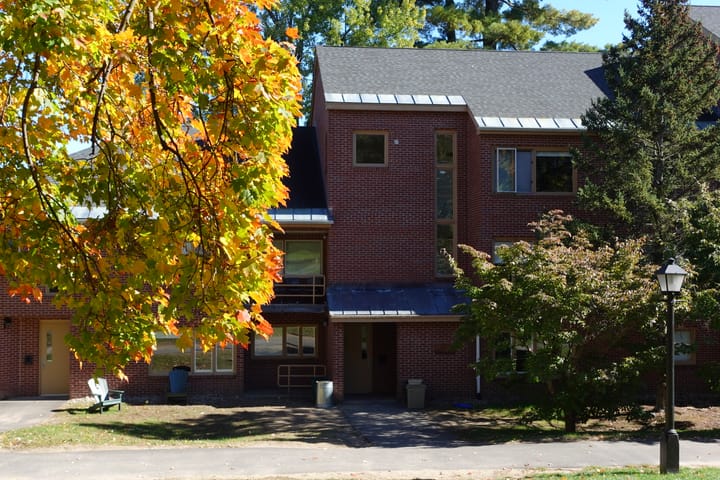You’re Not Reading The Amherst Student. That’s How Polarization Spreads
Contributing Writer Lucas Silva ’28 investigates the collapse of local journalism and asks what it would take for students and citizens alike to reclaim a stake in the information that shapes democracy.
Can you remember the last time you read your hometown paper, never mind Amherst’s? The last time you flipped through its flappy pages, or even bothered to open the digital edition?
Before coming to Amherst, I couldn’t.
That’s not just a lapse in habit. You might not even have a local newspaper if you’re from a rural town like me. Newsrooms are shuttering at an alarming rate, and in the void, our political language is increasingly polarized — more national, less local. My question is, are these variables related?
Briefing on “News Deserts”
Creative destruction has brought forward the downfall of the traditional business model of local newspapers. In the last 15 years, roughly 2,100 U.S. newspapers shut down — about one-fourth of all newspapers — and more than half of all local journalists were let go. To those who are left, the excessive workload burdens them, and they become increasingly unable to attend to particular topics of local interest. Consequently, as of 2019, 1,800 districts have lost their local paper entirely, and more than 200 counties have no newspaper at all.
These districts without a newspaper are called “news deserts.” Most news deserts are in Southern counties with a “substantially higher” average poverty rate. The trimming of news outlets has ushered in a new era of journalism dominated by media barons. Gradually, these conglomerates have centralized control over how news is produced and distributed. In fact, a 2020 report found that the 25 largest newspaper ownership chains now control one-third of the nation’s remaining 6,700 newspapers — including 70% of the 1,260 organizations that publish daily.
The prioritization of profit over quality in these newsrooms harms local journalism. Beyond the unequal pricing margin between what large and small companies can demand for their services, a Duke University study found that local reporting has been diluted in many communities. Eight of 100 local newspapers had no coverage of critical public issues, 12 had no original reporting, and 20 had no local news. Only 17% of stories were truly about the communities they served.
The on-the-ground effects are towns and cities with no agenda, no watchdog at city hall, no local reporter at school board meetings, maybe even no public accountability for local officials. The press, now more than ever amid constant attacks from the Trump administration, functions as the institutionalized conscience of democracy. When journalism falters, secrecy advances, and without proper investigation, local governments can manipulate budgets, contracts, or even public safety narratives without being challenged by evidence. Penny Abernathy, a leading researcher on news deserts, calls it an “extinction-level” threat to local journalism, and with it, the extinction of civic memory itself, the shared record that lets a community know what it stands for and what it’s lost.
When a town loses its newspaper, residents lose a vital channel for voicing concerns and holding power to account. Yet the damage runs deeper: The erosion of local news also weakens a community’s shared sense of identity — one that, in democratic societies, is built through informed participation. Studies show that residents with access to a daily paper voted more regularly than those without one, and that mayoral elections in news deserts tend to be less competitive. Even among those who keep voting, communities grow more polarized once their local paper disappears.
Therefore, what disappears with the local paper isn’t just information, but the genuine, applicable conversation through which a community understands itself, leaving an informational vacuum that national media and social platforms wrongly fill.
Informational Vacuum
Tech giants’ dominance over traditional media stems from data: Online platforms harvest user information to deliver precisely targeted feeds, giving them an enormous advantage over newspapers.
This shift has created a self-reinforcing cycle. Platforms’ proprietary data give them leverage over advertisers, who rely on that information to reach consumers efficiently. Local news organizations, meanwhile, struggle to attract ad revenue, while readers — used to “free” content on social media — see little reason to pay for journalism. As subscriptions fall, advertising revenue follows, weakening already fragile news cashflows. Even if local papers could collect user data, I suspect people would likely distrust them more than they do the tech giants.
With the increase of news deserts and a decrease in news sources, we witness an “informational vacuum.” The term describes a breakdown in locally sourced, fact-checked information. Misinformation skyrockets and reaches dimensions never seen before here. Studies show that false stories online, typically crafted as eyebrow-raising, “diffuse six times faster than the truth,” routinely reaching up to 100,000 users before any correction can spread. While traditional media is limited by the expertise, training, and supervision of journalists, the nature of social media also allows the uneducated eye to author with less governance. Therefore, we are battling to filter harmful information shared by individuals and large companies.
The same actors that let misinformation flourish online now infect parts of the local-news ecosystem. A 2020 report by James R. Shepley Distinguished Professor of Public Policy at Duke University Philip Napoli, found more than 400 partisan outlets “masquerading” as local news, most owned by a small group of conservative-leaning media companies and political operatives. These sites often mimic the look and tone of hometown papers — complete with community sections, weather updates, etc. Still, their content is largely syndicated or algorithmically generated to push political talking points — over half target local or hyperlocal audiences, occupying the space once held by genuine community reporting.
This imitation of local journalism poses clear dangers. When partisan outlets present opinion-driven coverage as neutral reporting, they deepen polarization and distort civic understanding. Without trusted local outlets, more people turn to online substitutes, further eroding the foundations of an informed democracy.
Partisan Heuristics and Nationalizing Yourself
In decades past, Americans often distinguished between local and national candidates — voting for different parties in different races based on the issues on the table. Today, that independent streak is fading. The outcomes of congressional, state, and local races increasingly march in lockstep with presidential politics. Local and state candidates rise or fall based on the “R” or “D” after their name, rather than their individual merits or community reputation.
In part, this boils down to party heuristics. When local coverage wanes and voters don’t even know the issues the town is going through, they fall back on the simplest cue: partisan identity. In other words, a strong local press can loosen the grip of national partisanship on voters’ choices, for voters to say, “I’ll vote for a different party for governor than I did for president, because I know the governor’s record and it matters more than partisan alignment.”
However, issues that once might have transcended party lines (say, a corrupt local official or a school funding referendum) are now filtered through partisan lenses. The less local reporting there is, the more voters depend on what their preferred national media and party leaders say, even about local matters. Over time, this pattern trains voters to see every contest as a miniature Battle of Republicans versus Democrats. The ideological hardening is palpable. Surveys show Americans increasingly dislike people with different party affiliations personally, and partisan identity has become a core part of social identity for many, even influencing non-political life choices, like whom to date or where to worship. Scholars call this affective polarization, and it’s growing. The media environment plays a role: Coverage that highlights partisan conflict drives up animosity, and with fewer local stories of cross-party cooperation or community success, the perception of politics as pure zero-sum warfare only intensifies. When coverage of Trump voters only centers on far-right activists rather than the many disillusioned moderates or former Democrats among them, it constructs a caricature of polarization that audiences then internalize as reality.
Again, the decline of local media is eroding this ability. A landmark 2018 study by Associate Professor of Political Communication at Syracuse University Joshua Darr, quantified the effect. They found that when a local newspaper shuts down, split-ticket voting drops by a small but significant margin — about 1.9%. That may sound minor, but it’s enough to tip outcomes in our era of razor-thin election margins. For context, in the 2022 midterms, dozens of U.S. House races were decided by less than two percentage points, and control of the chamber hinged on fewer than a dozen close contests. In communities where the paper closed, voters became less likely to cross party lines, suggesting they relied on the “straight ticket” default without independent local reporting.
What to do?
There are many well-thought-out proposals to address this damage. Most involve rebalancing the information economy and curbing misinformation, and some solutions are contingent on the student’s scope and education.
Sadly, most Americans are unaware of the dire situation of local journalism. Surveys show that 71% of respondents believe their local media are doing well financially, even as over one-fourth of U.S. newspapers have disappeared.
To keep a crucial pillar of democracy alive, we must speak up and be more critical and aware of the information we consume. Your time on mega-platforms feeds into the “data oligarchy” of Google, Meta, TikTok, and Amazon. Value your information — and by extension, yourself — more! Explore other news revenue that isn’t affiliated with the aforementioned industry giants.
Amherst College administration must circulate and advertise the Amherst Bulletin, Daily Hampshire Gazette, The Amherst Current, and The Amherst Student more through their communication channels. Exploring partnerships between on-campus reporting and local media outlets with the help of the Center for Community Engagement (CCE) ensures students gain professional reporting while local papers regain the capacity they’ve lost. Another opportunity is replicating University of Vermont’s Community News Service. Students there file edited, fact-checked stories that any local paper can republish free of charge, simply by crediting the author and the university.
This issue also falls within the college’s incessant push for pro-democratic discussion and careers. Therefore, the college could also sponsor reporting stipends for students covering municipal issues or updating local news outlets’ websites, modeled on the City Bureau “Documenters” initiative in Chicago, where citizens are paid to attend and summarize public meetings.
On Nov. 4, most of the country will be voting in local elections, and I hope the student body will, too. No single fix will suffice, but making this issue an introductory conversation with local officials is a start. The Amherst community can lead by example. Students can press town candidates on how they plan to sustain local reporting — whether through tax incentives for small-market advertising, partnerships with college media, or grants for civic-information initiatives. The Amherst Student is a public-service institution, not just a student club. Reviving local journalism is not nostalgia or pity; it’s the basis of truth in an age where we can’t always trust what we read online. And in a town that still prints its stories on paper every Wednesday, Amherst College has the means and the mandate to keep them alive.





Comments ()